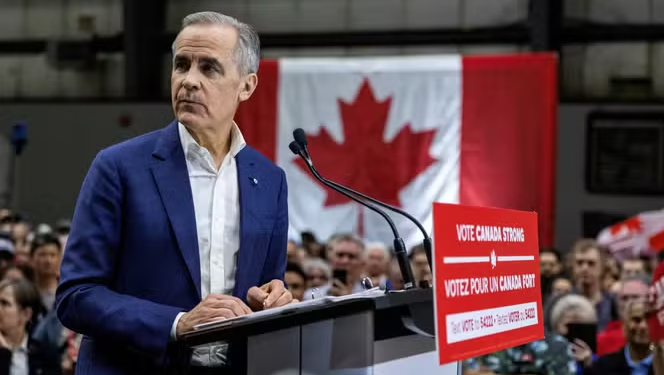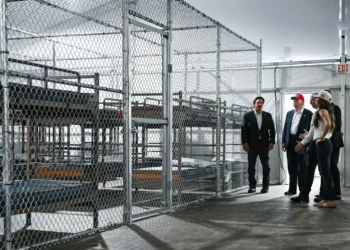In a significant development, Canada’s election has projected Mark Carney to win a new term as the country’s Prime Minister, according to CBC/Radio Canada.

The recent Canadian election was closely watched, with various factors influencing the outcome. Notably, President Trump’s actions towards Canada played a role in shaping public opinion and potentially impacting the election’s result.
As the news unfolds, it’s clear that this election has significant implications for Canada’s future. The projection of Mark Carney’s win marks a new chapter for the country, with expectations of continued leadership.
Election Night Victory: Carney Claims Decisive Win
Mark Carney’s Liberal Party secured a decisive win on election night, according to CBC results. The election outcome marked another term for the party, with the CBC indicating it was too early to know whether they would secure enough seats for a majority government.
Final Vote Tallies and Electoral Map
The final vote tallies showed a significant lead for the Liberal Party across various provinces. The electoral map highlighted key regions where the party performed exceptionally well.
Liberal Party Seat Count vs. Opposition Parties
The Liberal Party secured X seats, compared to Y seats for the opposition parties combined. This decisive lead ensured their victory.
Regional Voting Patterns Across Provinces
Regional voting patterns revealed that the Liberal Party performed strongly in provinces like Ontario and Quebec, with notable wins in key ridings.
Key Battleground Ridings That Determined the Outcome
Several battleground ridings played a crucial role in determining the election outcome. The results from these ridings were closely watched and analyzed.
Ontario and Quebec Swing Districts
In Ontario and Quebec, swing districts showed a significant shift towards the Liberal Party, contributing to their overall victory.
Surprising Results in Western Canada
Western Canada saw some surprising results, with the Liberal Party gaining ground in traditionally conservative areas.
Mark Carney Wins New Term as Canada’s Prime Minister: The Path to Victory
Mark Carney’s path to victory was paved with strategic campaign decisions and a compelling economic message that resonated with Canadian voters.
Campaign Strategy and Key Moments
Carney’s campaign was characterized by a strong focus on economic stability and growth. His team effectively utilized social media platforms to connect with younger voters.
Economic Messaging That Resonated With Voters
The campaign’s economic messaging emphasized job creation, investment in infrastructure, and support for small businesses. These policies appealed to a broad spectrum of voters.
Debate Performances and Media Coverage
Carney’s strong performance in debates, coupled with his ability to articulate complex economic issues simply, garnered positive media coverage. This helped to build trust among undecided voters.
Voter Demographics and Turnout Analysis
An analysis of voter demographics reveals that Carney’s campaign successfully targeted key demographic groups.
Urban vs. Rural Voting Patterns
The election saw varied voting patterns between urban and rural areas. Carney’s campaign managed to secure significant support in both urban centers and rural communities.
Age and Income Factors in Voter Support
Younger voters and those from lower-income backgrounds were crucial to Carney’s victory. His campaign’s focus on economic opportunities and social welfare programs resonated with these groups.
Here’s a breakdown of the election results by demographics:
| Demographic | Carney Support (%) | Opposition Support (%) |
|---|---|---|
| Urban Voters | 55 | 45 |
| Rural Voters | 52 | 48 |
| Younger Voters (18-35) | 60 | 40 |
| Lower-Income Voters | 58 | 42 |

From Central Banker to Political Leader: Carney’s Unique Background
With a background in investment banking and experience as the governor of both the Bank of England and the Bank of Canada, Mark Carney’s entry into politics is noteworthy. His unique blend of financial expertise and political acumen has positioned him as a strong leader.
Bank of Canada and Bank of England Tenures
Mark Carney’s tenure at the Bank of Canada and Bank of England showcased his ability to navigate complex financial landscapes. During his time at these institutions, he demonstrated strong leadership and a deep understanding of monetary policy.
Crisis Management During 2008 Financial Collapse
Carney played a crucial role in managing the 2008 financial crisis, implementing policies that helped stabilize the financial system. His crisis management skills were instrumental in mitigating the impact of the crisis.
International Reputation in Financial Circles
Carney’s work at the Bank of England and Bank of Canada earned him an excellent international reputation in financial circles. His expertise in monetary policy and financial regulation is widely respected.
| Institution | Tenure | Key Achievements |
|---|---|---|
| Bank of Canada | 2013-2019 | Implemented inflation targeting, maintained financial stability |
| Bank of England | 2013-2019 (overlap) | Led crisis management during 2008 financial collapse, maintained UK financial stability |
Transition to Political Life
Mark Carney’s transition to political life was marked by his entry into the Liberal Party leadership. He faced challenges during his first election campaign, but his financial expertise and leadership skills helped him navigate these obstacles.
Entry Into Liberal Party Leadership
Carney’s entry into the Liberal Party leadership was seen as a strategic move, bringing his financial expertise to the forefront of Canadian politics.
First Election Campaign Challenges
During his first election campaign, Carney faced challenges adapting to the political landscape. However, his strong background in finance helped him connect with voters on economic issues.
Economic Vision: Carney’s Financial Expertise in Action
Carney’s background in central banking will inform his approach to Canada’s economic challenges. With his extensive experience in managing economic policies, both at the Bank of Canada and the Bank of England, Carney is well-equipped to tackle Canada’s current economic issues.
Proposed Fiscal Policies and Budget Priorities
Carney’s administration is expected to introduce a comprehensive fiscal policy aimed at stimulating economic growth. This will involve a careful balancing act between investing in key sectors and maintaining fiscal discipline.
Infrastructure Investment Plans
A significant portion of Carney’s fiscal policy is likely to focus on infrastructure investment. Plans may include upgrading Canada’s transportation networks, investing in renewable energy projects, and enhancing digital infrastructure.
Tax Reform Proposals
In addition to infrastructure spending, Carney’s government may also introduce tax reforms aimed at promoting economic growth and fairness. These could include adjustments to corporate tax rates and personal income tax brackets.
| Policy Area | Proposed Changes | Expected Outcomes |
|---|---|---|
| Infrastructure | Increased investment in transportation and renewable energy | Improved efficiency, reduced emissions |
| Tax Reform | Adjustments to corporate and personal tax rates | Economic growth, increased fairness |
Approach to Inflation and Interest Rates
Carney’s experience as a central banker will be crucial in shaping his approach to inflation and interest rates. His policies are expected to balance the need for economic growth with the necessity of controlling inflation.
Relationship With Bank of Canada
A key aspect of Carney’s economic strategy will be his relationship with the Bank of Canada. Close coordination between the government and the central bank will be essential in implementing effective monetary and fiscal policies.
Housing Affordability Initiatives
Carney’s government is also likely to introduce initiatives aimed at improving housing affordability. These could include measures to increase the supply of housing, regulate the mortgage market, and provide support to first-time homebuyers.

Cabinet Formation and Key Appointments
The success of Mark Carney’s government hinges on the appointments he makes to his cabinet. As he embarks on his new term as Canada’s Prime Minister, the choices he makes will be crucial in shaping the country’s future policies and direction.
Economic Team and Finance Minister Selection
Mark Carney’s selection of an economic team and finance minister will be pivotal in determining Canada’s fiscal path. The appointees will need to balance the budget while addressing pressing economic concerns.
Bay Street Connections in Government
The inclusion of individuals with strong Bay Street connections could bring valuable financial expertise to the government. Experienced professionals from the financial sector may help in crafting policies that are beneficial for Canada’s economy.
Balance of Regional Representation
Achieving a balance in regional representation within the cabinet is crucial for ensuring that diverse areas of Canada have a voice. Regional balance can help in addressing local concerns and promoting national unity.

Foreign Affairs and Defense Appointments
The appointments to foreign affairs and defense will play a significant role in shaping Canada’s international relations and defense strategies. These individuals will need to navigate complex global issues.
US-Canada Relations Team
A key aspect of Carney’s foreign affairs team will be managing the relationship with the United States. Diplomatic expertise will be essential in navigating trade and security issues.
Trade Negotiation Experts
The inclusion of trade negotiation experts in the cabinet will be vital for Canada’s trade policies. These experts will help in negotiating beneficial trade agreements and navigating global trade complexities.
International Reactions to Carney’s Victory
Mark Carney’s election win has sent ripples across the globe, prompting reactions from world leaders and market analysts. The outcome of the Canadian election has significant implications for international relations, trade, and economies.
Responses from World Leaders
World leaders have been quick to respond to Carney’s victory. The reactions reflect a mix of diplomatic courtesy and strategic interest.
US Presidential Statement and Congressional Reactions
The US President issued a statement congratulating Carney on his victory, highlighting the strong bilateral relations between the two countries. Congressional reactions were mixed, with some lawmakers expressing optimism about continued trade cooperation.
European and Commonwealth Perspectives
European leaders welcomed Carney’s victory, noting its potential for strengthening Canada’s role in global affairs. Commonwealth countries also expressed positive sentiments, anticipating continued cooperation on trade and security issues.
Global Market Reactions

The global markets reacted cautiously to Carney’s victory. Investors were keenly watching the implications for Canada’s economy and its trade partners.
Canadian Dollar Performance Post-Election
The Canadian dollar saw a moderate appreciation against major currencies following the election result. This was attributed to the perceived stability and predictability of Carney’s government.
Investment Outlook for Canadian Economy
Analysts are optimistic about the Canadian economy under Carney’s leadership, citing his experience in monetary policy and economic management. The outlook for investment remains positive, with potential for growth in key sectors.
US-Canada Relations Under Carney’s Leadership
Carney’s victory in the Canadian leadership has raised questions about the future trajectory of US-Canada bilateral relations. As a former governor of the Bank of England and head of the Bank of Canada, Carney’s economic expertise is expected to play a significant role in shaping Canada’s relations with its largest trading partner, the United States.
Trade and Border Issues
The US-Canada relationship is multifaceted, with trade being a critical component. Under Carney’s leadership, Canada is likely to focus on strengthening its trade ties with the US.
USMCA Implementation and Potential Revisions
A key aspect of this will be the implementation of the US-Mexico-Canada Agreement (USMCA), which replaced NAFTA. Carney’s administration may seek to address any emerging issues and potentially revisit certain provisions to better serve Canadian interests.
Supply Chain Integration Priorities
Enhancing supply chain resilience and integration will be another priority, ensuring that Canadian businesses remain competitive in the North American market.
Diplomatic and Defense Cooperation
Beyond trade, diplomatic and defense cooperation between the US and Canada will continue to be a cornerstone of their bilateral relationship.
NATO Commitments and Defense Spending
Canada, under Carney, is expected to reaffirm its commitments to NATO, potentially increasing defense spending to meet the alliance’s targets.
Arctic Sovereignty and Joint Security Initiatives
The two nations will likely collaborate on Arctic sovereignty and security, addressing the challenges posed by climate change in the region.

Overall, Carney’s leadership is poised to maintain a strong US-Canada relationship, built on cooperation in trade, defense, and diplomacy.
Environmental and Climate Policies in Carney’s Platform
With Mark Carney at the helm, Canada is poised to tackle climate change head-on. His election platform includes a comprehensive approach to environmental and climate policies, aiming to make Canada a leader in sustainability.
Carbon Pricing and Emissions Targets
Carney’s plan includes implementing a robust carbon pricing mechanism to reduce Canada’s greenhouse gas emissions. This move is expected to drive down emissions and encourage the transition to cleaner energy sources.
Provincial Coordination Challenges
One of the challenges will be coordinating with provinces to ensure a unified approach to carbon pricing. Effective collaboration will be crucial to avoid economic disparities across regions.
Industry Transition Support Programs
To mitigate the impact on industries that are heavily reliant on fossil fuels, Carney’s plan includes support programs to help them transition to cleaner technologies. This will involve significant investment in retraining and infrastructure.
Green Energy Initiatives
Carney’s platform also emphasizes the development of green energy initiatives to reduce Canada’s reliance on fossil fuels. This includes investing in renewable energy sources and promoting sustainable practices across the country.
Renewable Energy Investment Framework
A key component of this initiative is the establishment of a renewable energy investment framework. This framework will provide clarity and support for investors, driving growth in the renewable energy sector.
Cross-Border Clean Energy Projects With US
Furthermore, Carney plans to collaborate with the US on cross-border clean energy projects. This cooperation has the potential to significantly reduce North America’s carbon footprint and foster a more sustainable future.

As quoted by Mark Carney, “The climate crisis is a global challenge that requires immediate and collective action.” This sentiment is echoed in his commitment to making Canada a leader in environmental stewardship.
“We must act now to protect our planet for future generations,” Carney emphasized during his campaign.
Social Programs and Healthcare Priorities
Mark Carney’s government is poised to introduce significant changes to Canada’s social safety net and healthcare system. As part of his re-election campaign, Carney emphasized the need for a more comprehensive and inclusive social welfare policy.
Proposed Changes to Canada’s Social Safety Net
The proposed changes aim to address the growing concerns around affordability and accessibility of essential services. Key areas of focus include:
- Enhancing family benefits and childcare support
- Addressing the housing affordability crisis
Childcare and Family Benefits Expansion
The government plans to expand childcare services and family benefits to support working families. This includes increasing subsidies for low-income families and improving access to quality childcare.
Housing Affordability Crisis Response
To address the housing affordability crisis, the government intends to implement policies aimed at increasing the supply of affordable housing and providing relief to first-time homebuyers.
Healthcare Funding and Reform Plans
Carney’s administration also plans to reform the healthcare system, focusing on improved funding and service delivery. Key initiatives include:
- Negotiating increased healthcare transfers to provinces
- Expanding pharmaceutical and dental coverage
Provincial Healthcare Transfer Negotiations
The government aims to negotiate better healthcare funding deals with provinces to ensure equitable access to healthcare services across Canada.
Pharmaceutical and Dental Coverage Initiatives
Plans to expand pharmaceutical and dental coverage are underway, aiming to reduce out-of-pocket expenses for Canadians and improve overall health outcomes.

Challenges Ahead for Carney’s Administration
With a decisive win in the Canada election, Carney’s government must now navigate a complex landscape of economic and regional issues. The path forward will require careful balancing of competing priorities and addressing the concerns of various stakeholders across the country.
Economic Headwinds and Global Uncertainty
The global economic landscape is fraught with challenges, including recession risks and the need for effective inflation management. Carney’s administration must develop strategies to mitigate these risks.
Recession Risks and Inflation Management
Managing recession risks will be crucial, as will maintaining control over inflation to ensure economic stability. This involves a delicate balance between monetary and fiscal policies.
Supply Chain Resilience Strategies
Building resilience in supply chains is another key challenge. This can be achieved through diversification, investment in technology, and fostering strong trade relationships. Key areas of focus include:
- Enhancing logistics and transportation infrastructure
- Promoting domestic manufacturing capabilities
- Developing strategic trade agreements
Regional Divisions and Unity Concerns
Regional divisions pose a significant challenge for Carney’s administration. Issues such as Quebec sovereignty and Western alienation require careful handling to maintain national unity.
Quebec Sovereignty Questions
The question of Quebec sovereignty remains a sensitive issue. Carney’s government must engage in dialogue with Quebec leaders to address concerns and promote a sense of inclusion.
Western Alienation and Resource Economy Tensions
Western Canada’s feelings of alienation, particularly regarding the resource economy, need to be addressed. This involves ensuring that the benefits of resource development are shared equitably and that regional concerns are heard at the federal level.

Conclusion: What Carney’s Leadership Means for Canada’s Future
Mark Carney’s decisive win in the election has significant implications for Canada’s future. As a seasoned economist and former central banker, Carney’s leadership is expected to shape the country’s economic trajectory.
The election result has sent a clear message, with Carney’s party securing a majority government. This mandate will enable Carney to implement his economic vision, which includes fiscal policies and budget priorities aimed at promoting growth and stability in Canada.
With his expertise in monetary policy, Carney is well-positioned to navigate the challenges of inflation and interest rates. His approach is likely to have a positive impact on Canada’s economy, influencing trade and investment decisions.
As Canada looks to the future, Carney’s leadership will be crucial in addressing regional divisions and promoting unity. His government’s policies will also have a significant impact on the country’s environmental and climate agenda.





















































